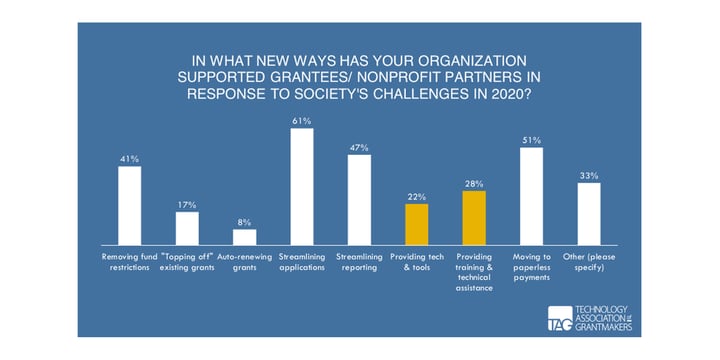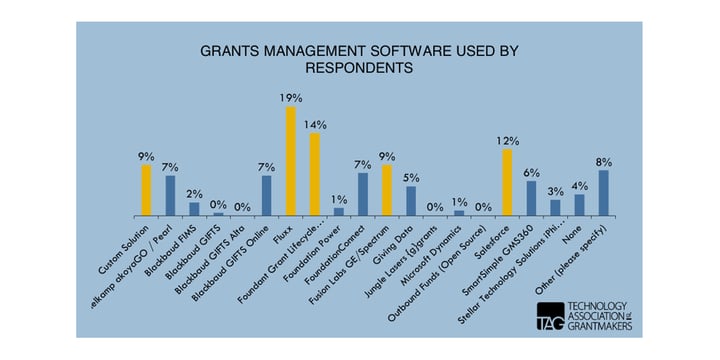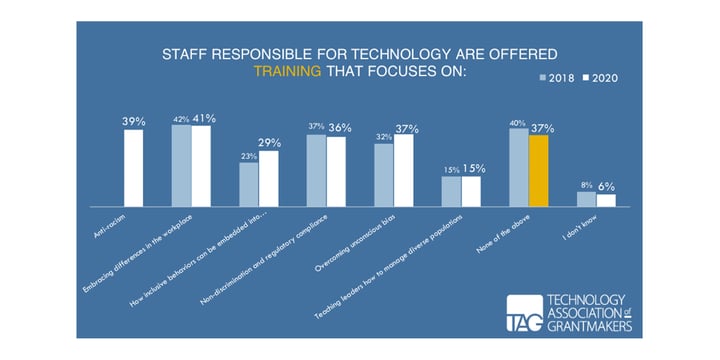2020 was disruptive, but how might we know which changes will stick around?
Back in December, I identified a few trends with “staying power” on the NTEN blog at 3 Ways Philanthropy Tech Will Change in 2021. There, I described how results from a recent survey by the Technology Association of Grantmakers (TAG) identified key practices already underway in the technology landscape for funders as well as new practices that have emerged as a result of the crises of 2020. There are many implications in the findings for the nonprofits that work with foundations. Here are some insights from the NTEN article as well as others that I hope will be useful to TechSoup members.

3 Key Trends Affecting Both Funders and Nonprofit Partners
Funders and nonprofit partners share a technology ecosystem for social change. It’s therefore helpful to stay on top of key trends. Below are three ways that technology tools and practices have evolved in philanthropy, including surprising shifts as a result of the pressures of 2020.
- Increasing focus on the grantee experience of a foundation’s tools, systems, and practices
- Leading software choices that tend to include support for grantee tools
- Expanding support for racial equity to tech teams, vendors, and partners
The Grantee Experience Matters More than Ever
Likely no surprise to TechSoup members, the grantee experience of philanthropy can make or break a nonprofit’s mission. This realization was pivotal for many funders who quickly recognized at the onset of the pandemic that changemakers needed funds, tools, and support without the usual overhead of process and paperwork.
As I shared with NTEN, this “make or break” reality in 2020 became a clarion call for philanthropy to streamline and support the grantee experience more than ever before. As shown in the chart below, 61 percent of responding foundations report streamlining the grant application process in response to COVID-19, while 47 percent report streamlining the reporting process this year. Recognizing and rapidly reducing the burden on grantees of onerous application and reporting is a heartening change in philanthropy. However, some funders went even further as shown below in orange. According to our survey, 28 percent of responding foundations in 2020 provided training and technical assistance directly to grantees, while 22 percent report providing tools and tech.

These changes in philanthropy, coupled with efforts such as #FixtheForm, which surveyed 500 nonprofits to identify pain points in grant application systems, are the harbingers of a fundamental shift for funders. This shift I’m seeing is a recognition that the grantee experience of philanthropy is one of the key constraints for enacting social change on the ground — a recognition that I hope becomes a driving force for continued improvement in philanthropy.
Funder Software Choices Point to Better Support for Grantees
Of course, a core element of the foundation toolstack is the software selected for grant application, management, and reporting. The implications of this choice are wide-ranging because the grants management system (GMS) fundamentally defines the ways in which a nonprofit interacts with its foundation partners. While there are many strong choices available, the results of the 2020 State of Philanthropy Tech survey reveal four leading platforms in use. It’s noteworthy that several include software for the nonprofit side to ease reporting and communication.
- Fluxx is the most popular grants management software that foundations use. Fluxx offers a no-cost software service for nonprofits called Fluxx Grantseeker that integrates on the Fluxx platform to track and share impact with funders.
- Foundant Grant Lifecycle is also popular with foundations. Foundant hosts an application for nonprofits called GrantHub that also tracks and reports your progress with funders.
- Salesforce is third on the list. The Salesforce Nonprofit Success Pack is their product for nonprofits.
- Fusion Labs GE is fourth in popularity among foundations. They host GE Spectrum, which integrates with Blackbaud.
Below are the complete results from all 233 foundation respondents.

It’s worth noting that when segmenting these results by type of organization (e.g., family foundations or community foundations), different systems become more prominent. For example:
- For family foundations, Fluxx (29 percent) and GivingData (22 percent) are the most popular grants management systems.
- For community foundations, Foundant Grant Lifecycle Manager (29 percent) is the most popular grants management system.
Racial Equity Expands to Include Tech Teams and Partner Organizations
Like many in the TechSoup community, philanthropy has accelerated its funding and focus on the work of racial equity. However, one finding from the State of Philanthropy Tech survey shows that operations teams such as IT departments are often left behind when training and programs are offered. This gap was first identified in the 2018 survey by TAG. At the time, 40 percent of responding foundations reported that no diversity, equity, and inclusion (DEI) training whatsoever was offered to technology staff. In 2020, TAG saw a small improvement from 40 percent to 37 percent offering no DEI training for tech teams. But clearly, it’s time for a systemic focus on advancing equity within philanthropy and its nonprofit partners.

There’s room for optimism: Already among the TAG membership, I’m seeing organizations commit to providing DEI training not only for IT staff but for contractors and vendors as well. I’m seeing organizations recognize that they need to move beyond a “check the box” approach to hiring diverse staff and also provide development and leadership cultivation.
This shift is an opportunity for nonprofit partners to engage their funders in a conversation about holistic approaches to equity efforts. For example, what would it look like for funders to offer equity training for nonprofit partners and technology providers? Or conversely, imagine nonprofit partners inviting funders into their own equity programs. 2021 presents a door to open toward new conversations about a systems-change approach to equity.
This article was first published on TechSoup by Chantal Forster. Forster is the executive director of the Technology Association of Grantmakers (TAG).
